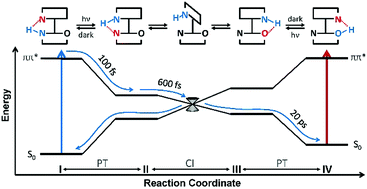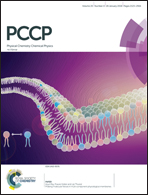Ultrafast dynamics of the ESIPT photoswitch N-(3-pyridinyl)-2-pyridinecarboxamide†
Abstract
Molecular switches based on proton transfer that are photochromic and can be interconverted by light at different wavelengths back and forth between two thermodynamically stable tautomeric states in solution at room temperature are rare to date. We report on a study of the ultrafast conversion of the bistable proton transfer switch N-(3-pyridinyl)-2-pyridinecarboxamide (NPPCA) to a corresponding iminol after photoexcitation at λpump ≈ 265 nm by means of femtosecond time-resolved broad-band and single-colour transient electronic absorption spectroscopy (TEAS), transient fluorescence spectroscopy (TFLS), and transient vibrational absorption spectroscopy (TVAS) in acetonitrile solution. The interpretation of the data was accompanied by ab initio quantum chemical calculations of the excited electronic states and the vibrational frequencies of the reactant and product in their ground electronic state. The TEAS experiments provided four time constants, τ1 = 0.09 ± 0.01 ps, τ2 = 0.61 ± 0.01 ps, τ3 = 5.10 ± 0.80 ps, and τ4 = 20.0 ± 1.0 ps. The first two agree well with the measured TFLS lifetimes, τ1,TFL < 0.18 ps and τ2,TFL = 0.50 ± 0.01 ps. τ1 is related to the relaxation of the initially excited Franck–Condon (FC) state of the pyridinecarboxamide, followed by the excited-state intramolecular proton transfer (ESIPT) step to the neighbouring pyridine. The subsequent return of the molecules to the electronic ground state takes place within τ2, mediated by a conical intersection (CI) at a twisted configuration of the pyridinecarboxamide moiety. The main components in all TEAS time profiles feature a rise with τ2 and a decay with τ4 and describe subsequent molecular transformations in the electronic ground state. τ3 is ascribed to vibrational cooling of the molecules. The final iminol exhibits a permanent UV absorption at λ = 247 nm, where its absorbance is stronger than that of the carboxamide reactant. The iminol structure is unambiguously identified by the TVA spectra, which show the build-up of corresponding vibrational bands with τ4,TVA = 23 ± 2 ps after the initial bleach of the reactant vibrational bands, in excellent agreement with the TEAS data. Its lifetime is >10 ns.



 Please wait while we load your content...
Please wait while we load your content...